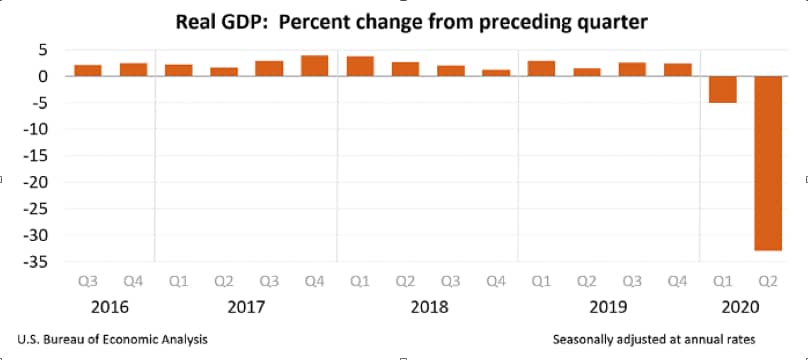Putting the Worst GDP Drop Ever in Perspective
Remember back in late May when the Commerce Department reported that our U.S. economy shrank at an even faster pace than previously estimated in the first quarter of 2020 and consensus expectations suggested that the second quarter of 2020 would be far worse? Well, it happened.
On Thursday, July30th, the Commerce Department reported that GDP decreased at an annual rate of 32.9% in the second quarter of 2020. It was the worst quarterly decline in history.

That almost 33% decline is on the heels of the 5% decline in the first quarter.
GDP – A Very Complete Picture
The Commerce Department’s Bureau of Economic Analysis compiles the GDP report monthly and it is one of the most closely-watched reports on our economy given how much economic information it contains. Not only does the GDP report provide detailed data on how our economy is performing, but it also provides data that can help investors identify certain trends going forward. Broadly speaking, there are four main components of the GDP report, including:
- Personal consumption;
- Business investment;
- Government spending; and
- Net exports.
The data from the BEA’s GDP report includes a wealth of information, including details on how much we spend and on what, inflation indices, corporate profits and details on imports and exports.
As such, all investors should heed GDP numbers because the data paints a very good picture of the economic backdrop for both equity and fixed-income markets alike, which of course helps inform the performance of their portfolios.
But it’s also important to keep recent GDP numbers in perspective.
Reasons for the Decline in GDP
Unless you’ve been living under a rock, you know the reason behind the drop in our GDP: COVID-19. In fact, this is taken directly from the GDP release:
“The decline in second quarter GDP reflected the response to COVID-19, as “stay-at-home” orders issued in March and April were partially lifted in some areas of the country in May and June, and government pandemic assistance payments were distributed to households and businesses. This led to rapid shifts in activity, as businesses and schools continued remote work and consumers and businesses canceled, restricted, or redirected their spending. The full economic effects of the COVID-19 pandemic cannot be quantified in the GDP estimate for the second quarter of 2020 because the impacts are generally embedded in source data and cannot be separately identified.”
Glass Half-Full GDP
Remember in early June when it was generally accepted that GDP would sink further in the second quarter of 2020, when the impact of shutdowns and layoffs were felt more dramatically?
In fact, many economic models were predicting that GDP would sink to an annual rate of more than 50% in the second quarter, which would be the biggest quarterly decline on record and a whopping 5-times greater than the previous record set more than 60 years ago in 1958.
Consider this glass-half full comment:
- The GDPNow model that is published by the Federal Reserve Bank of Atlanta (which they are quick to point out is not an official forecast of the Atlanta Fed or a forecasting model) from June 1st – that was less than two months ago – estimated that real GDP growth in the second quarter of 2020 would be -52.8%.
Well, -32.9% is better than a -52.8%; so, there’s that.
And One More Thing…
The Congressional Budget Office predicted that GDP will rise at an annual rate of 21.5% for the third quarter of 2020, a number that will undoubtedly move around as more data comes in.

Social Share
Copyright © 2020 RSW Publishing. All rights reserved.
Distributed by Financial Media Exchange.
